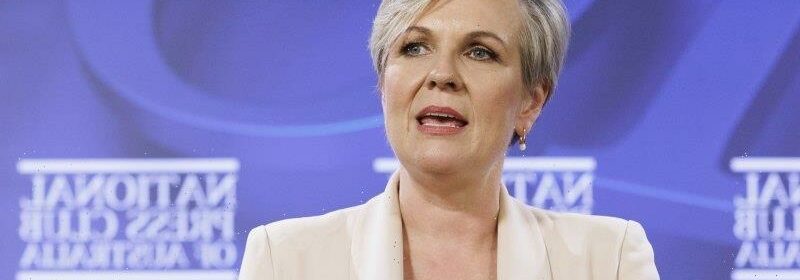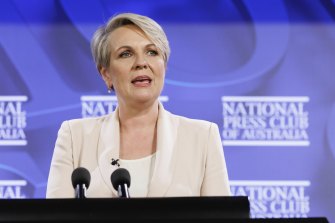Morrison has been rightfully condemned on climate. Let’s hope Labor can do better

Don’t put your trust in governments, former prime minister Scott Morrison told a congregation of churchgoers in Perth on Sunday. He should know: it was his government that took receipt of the 2021 State of the Environment report towards the end of last year and decided that instead of releasing it to the public it would simply shelve its damning findings until after the upcoming federal election.
Minister for the Environment and Water Tanya Plibersek addresses the National Press Club on Tuesday.Credit: Alex Ellinghausen
That the report – the latest five-yearly independent review – demands immediate action to stave off impending environmental catastrophe was apparently of little consequence to him and his environment minister, Sussan Ley. Political expediencies took precedence.
On Tuesday the new federal Environment and Water Minister, Tanya Plibersek, released the report, which details how Australia’s natural environment has been abused, exploited and allowed to deteriorate in recent decades with too little interest or intervention from the country’s leaders. A 278-page overview catalogues wildlife losses due in part to the 7.7 million hectares of land cleared between 2000 and 2017. It says there are now more non-native plant species in Australia than native ones, that just two gigalitres of the 450 gigalitres of water for the environment promised under the Murray-Darling Basin plan had been delivered and that Australia has lost more mammal species than any other continent.
In some areas, several factors have combined in a cumulative series of blows: fires adding to the toll on species already battling habitat destruction, or logging making native species more vulnerable to introduced predators. The Black Summer bushfires of 2019 and 2020 alone destroyed over 8 million hectares of native vegetation, killing or displacing between 1 billion and 3 billion animals. Since 2016, when the previous State of the Environment report was released, 17 mammal species were been either added to the endangered list or upgraded to the critically endangered list, as well as 17 birds and 19 frogs.
And what have we been doing about it all? Less and less, says the report. While acknowledging a significant investment in the Great Barrier Reef Foundation, which was controversial at the time, and other one-off efforts, it found funding for core environmental projects has largely declined, noting: “National Landcare Program funding has decreased, there is no longer funding for new national reserves, there have been cuts to biodiversity research at CSIRO, and the national Climate Change Adaptation Research Facility was discontinued in 2019.” Professor Brendan Wintle, a global leader in conservation ecology, told The Age that current spending was just 5 per cent of what is needed.
We have yet to even mention global warming, which this report finds is responsible for exacerbating weather events and causing permanent damage to ecosystems such as Tasmania’s giant kelp forests. “We are now documenting widespread impacts of climate change,” the report’s lead author, Emma Johnston from the University of Sydney, told the ABC.
Plibersek said the report was a “shocking document” that revealed “a decade of government inaction and wilful ignorance”. But her own policy approach is as yet unclear. She said at the National Press Club on Tuesday that six weeks into the job she would not rule anything in or out, but would formally respond to the recent Samuel review into environment legislation by the end of the year, then develop new laws for 2023. The federal government will also set a goal of protecting 30 per cent of land and 30 per cent of oceans by 2030.
As Age climate and energy correspondent Mike Foley observed on Tuesday, to make any headway Plibersek must persuade her colleagues to invest heavily in the environment at the same time as the government tackles a debt spiral forecast to breach $1 trillion in 2023-2024.
At the very least Labor needs to show some urgency and ambition when it comes to combating climate change.
Plibersek is right to cast blame Morrison’s way. But we already knew where his government stood on the environment – the teal and green wave at the last election demonstrated that voters saw it too. The question is whether Labor can do any better. For all our sakes we must hope it can.
Gay Alcorn sends a newsletter to subscribers each week. Sign up to receive her Note from the Editor.
Most Viewed in Politics
From our partners
Source: Read Full Article
